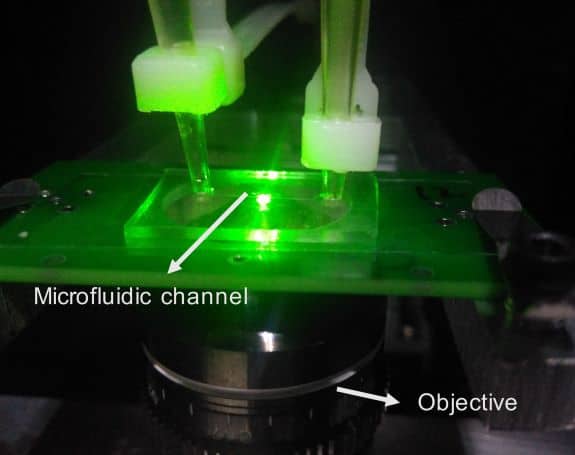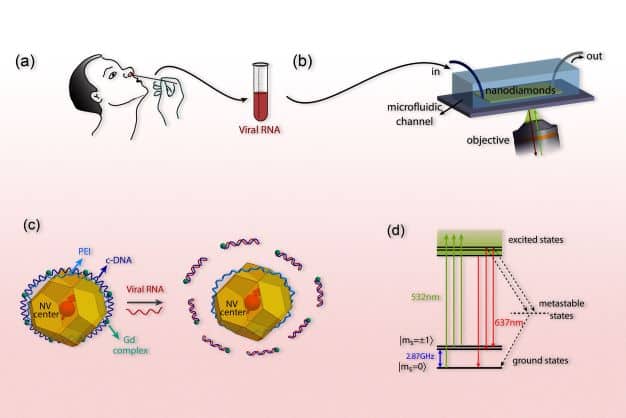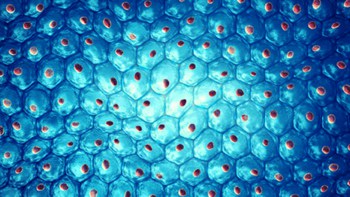
A quantum sensor based on nitrogen-vacancy centres in diamond could be used to detect viruses like SARS-CoV-2, which is responsible for the current COVID-19 pandemic. This is the finding of researchers at the University of Waterloo in Canada, who performed detailed mathematical simulations to show that the new technique would make it faster and cheaper to detect viruses with high accuracy.
Since November 2019, there have been more than 400 million reported cases of COVID-19 worldwide and nearly six million deaths. This huge toll highlights the importance of rapid and cost-effective tests that detect infection with low false negative rates (FNRs). Such tests allow preventive measures (such as asking infected individuals to isolate) to be taken early, when they are most effective. In the absence of treatments, testing also provides vital clues to help epidemiologists track the virus’s spread and contain outbreaks.
At present, the most accurate and widely-used tests for the SARS-CoV-2 virus rely on a technique known as reverse transcriptase quantitative polymerase chain reaction (RT-PCR), which detects the presence of the virus’ genetic material, or RNA. Extracting and amplifying this RNA from samples can take several hours and requires trained personnel, special testing and analytical equipment. Even so, the FNR for this method can exceed 25% depending on the viral load of samples and how they are obtained. This is a problem, since infected people who receive false negative results may not isolate and could go on to infect others.
An alternative, faster, technique is antigen testing. This involves detecting specific viral proteins, such as spike proteins, found on the surface of the virus. Antigen tests are, however, even less accurate than PCR tests. What is more, they cannot quantify the amount of virus present.
Quantum sensors based on NV centres
According to new work by Paola Cappellaro, Mohammad Kohandel and colleagues, this is where quantum sensors could come into their own. Though still in the early stages of development, such sensors have emerged in recent years as powerful tools for detecting chemical and biological signals, and the Waterloo team have identified sensors based on nitrogen-vacancy (NV) centres in diamond as particularly promising.

NV centres are defects in the diamond lattice that occur when two adjacent carbon atoms in the lattice are replaced by a nitrogen atom and an empty lattice site. Together, the nitrogen atom and the vacancy behave as a negatively-charged entity with an intrinsic spin and three spin sublevels, denoted |ms = 0⟩ and |ms = ±1⟩. Illuminating this NV– centre with a laser polarizes its spin into the |ms = 0⟩ sublevel, which fluoresces intensely. The system then relaxes to its thermal equilibrium state, which fluoresces less. This thermalization process occurs over a certain characteristic period of time known as the longitudinal relaxation time, T1, which depends on the magnetic field sensed by the NV centre in its environment. For this reason, NV centres can be used as highly sensitive magnetic resonance probes capable of monitoring changes to spins in a sample over distances of a few tens of nanometres.

How physics can help COVID-proof everyday life
The Waterloo team’s proposed device would be made by coating nanodiamonds containing NV– centres with cationic polymers such as polyethyleneimine (PEI), which can form reversible complexes with viral complementary DNA sequences. Magnetic molecules such as Gd3+ (gadolinium) complexes could then be incorporated into the sequence to form hybrid c-DNA-Gd pairs.
In the presence of viral RNA, these pairs will detach from the nanodiamond surface thanks to a process called c-DNA and virus RNA hybridization. The newly formed c-DNA-Gd3+/RNA compound will then freely diffuse in solution, thereby increasing the distance between the magnetic Gd and the nanodiamond. As a result of this increased distance, the NV centres will sense less magnetic “noise” and thus have a longer T1 time, which manifests itself in a larger fluorescence intensity.
Sensitive detection and low FNR
By optically monitoring the change in relaxation time using a laser-based sensor, the researchers say they could identify the presence of viral RNA in a sample and even quantify the number of RNA molecules. Indeed, according to their simulations, Cappellaro, Kohandel and colleagues, who report their work in Nano Letters, say that their technique could detect as few as a few hundred strands of viral RNA and boast an FNR of less than 1%, which is much lower than RT-PCR even without the RNA amplification step. The device could also be scaled up so that it could measure many samples at once and could detect RNA viruses other than SARS-CoV-2, they add.



